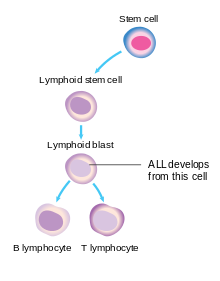Context
-
Recently, a child was diagnosed with a kind of blood cancer known as T-cell acute lymphoblastic leukaemia (T-ALL).
About T-cell acute lymphoblastic leukaemia (T-ALL)
- T-ALL affects the stem cells in the bone marrow that produce a particular kind of white blood cells (WBC) called T lymphocytes (T cells). These cells provide a person immunity by killing cells carrying infections, activating other immune cells, and regulating the immune response.

Source: Wikipedia - At least 20% of these WBC are atypical– as they accumulate in the bone marrow, they crowd out “good” WBCs and hence weaken the immune system. These unhealthy cells can also accumulate in other parts of the body like the liver, spleen and lymph nodes.
- While found in both children and adults, T-ALL’s incidence decreases with age.
How is T-ALL typically treated?
- Typical treatment for T-ALL is similar to that of any leukaemia– chemotherapy and stem cell/bone marrow transplant.
- Doctors will first administer multiple rounds of chemotherapy.
- This either kills the cancerous cells or stops them from further dividing.
- The exact schedule is guided by an individual’s age and general health.
- If this fails, and the individual is suitable, doctors will conduct bone marrow transplant. First the patient will undergo radiation therapy and/or chemotherapy that will kill the cancerous cells but also wreck an individual’s immunity system along with it. Thus, patients receive an infusion of healthy bone marrow cells that will hopefully multiply and restore immunity.
- Overall treatment for T-ALL is pretty effective– children have a survival rate of over 85 per cent after five years of receiving this treatment.
What is the experimental treatment?
- The child has received a dose of healthy T-cells from a donor that would hopefully attack her cancerous cells without destroying each other. Known as CAR-T therapy, this principle has been around for a while, but Alyssa’s case was different.
- Traditionally, CAR-T therapy involves adding a gene to T-cells that causes them to seek out and destroy cancerous cells.
- The modified cells are known as CAR-T cells. First, an individual’s own T-cells are removed, which are then modified and reintroduced to the individual.
- The problem with such an approach (besides the expense) is that very often, when an individual is really sick, it is simply impossible to obtain enough healthy T-cells to create CAR-T cells.
- While donors can provide healthy T-cells to an individual, these T-cells from a foreign body are going to attack every single cell in that patient’s body, making the treatment counterproductive.
- Thus, scientists have resorted to what is known as base editing– through this technique of genetic editing, they make it possible for one donor to supply T-cells to multiple recipients, without the traditional risks associated with it.
What is base editing?
- With advances in genetic technology, scientists have been able to zoom into a precise part of the genetic code to alter the molecular structure of just one base, effectively changing its genetic instructions.
Source: IE
Visit Abhiyan PEDIA (One of the Most Followed / Recommended) for UPSC Revisions: Click Here
IAS Abhiyan is now on Telegram: Click on the Below link to Join our Channels to stay Updated
IAS Abhiyan Official: Click Here to Join
For UPSC Mains Value Edition (Facts, Quotes, Best Practices, Case Studies): Click Here to Join
